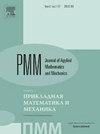Algorithms for the orientation of a moving object with separation of the integration of fast and slow motions
Abstract
Equations and algorithms for determining the orientation of a moving object in inertial and normal geographic coordinate systems are considered with separation of the integration of the fast and slow motions into ultrafast, fast and slow cycles. Ultrafast cycle algorithms are constructed using a Riccati-type kinematic quaternion equation and the Picard method of successive approximations, and the increments in the integrals of the projections of the absolute angular velocity vector of the object onto the coordinate axes (quasicoordinates) associated with them are used as input information. The fast cycle algorithm realizes the calculation of the classical rotation quaternion of an object on a step of the fast cycle in an inertial system of coordinates. The slow cycle algorithm is used in calculating the orientation quaternion of an object in the normal geographic coordinate system and aircraft angles. Results of modelling different versions of the fast and ultrafast cycle algorithms for calculating the inertial orientation of an object are presented and discussed. The experience of the authors in developing algorithms for determining the orientation of moving objects using a strapdown inertial navigation system is described and results obtained by them earlier in this field are developed and extended.

 求助内容:
求助内容: 应助结果提醒方式:
应助结果提醒方式:


